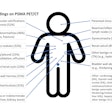Dear AuntMinnie Member,
This week we're featuring a report from the Alzheimer's Association International Conference in Honolulu, where researchers from the University of California, San Francisco highlighted their results in using a new PET radiopharmaceutical, currently in clinical trials, that could detect changes in the brain that are an early indication of Alzheimer's disease.
The presentation indicated that the radiopharmaceutical, florbetapir F18, binds to collections of beta amyloid in the brain; the researchers believe it is one of the first radiopharmaceuticals to do so. Learn more by clicking here, or visit our Molecular Imaging Digital Community at molecular.auntminnie.com.
MRI beats CT for stroke
In other news, German researchers performing a meta-analysis found that MRI is superior to CT in diagnosing acute ischemic stroke within 12 hours of a patient's first stroke symptoms.
The researchers analyzed four studies published between 2002 and 2007, concluding that MR with a diffusion-weighted imaging (DWI) protocol was superior to CT for ischemic stroke. They were unable to find high-quality studies indicating that MR with a perfusion-weighted imaging (PWI) technique was better than CT.
Learn more by clicking here, or visit the MRI Digital Community at mri.auntminnie.com.
Cardiac radiation dose
Finally, another new study examines a familiar topic -- radiation dose, this time from cardiac imaging procedures.
Researchers from Yale University in New Haven, CT, examined the dose delivered to nearly 100,000 patients, determining that while SPECT myocardial perfusion imaging (MPI) delivered the largest dose in aggregate, cardiac CT is expected to be a big contributor to overall dose in coming years.
Read all about it by clicking here, or visit our Cardiac Imaging Digital Community at cardiac.auntminnie.com.















